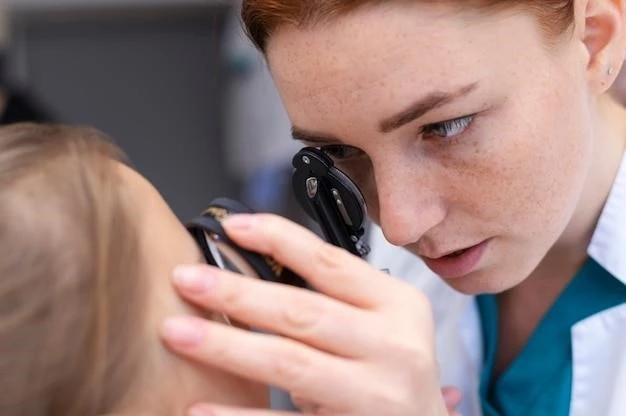Understanding Immotile Cilia Syndrome Due to Excessively Long Cilia
Understanding Immotile Cilia Syndrome characterized by excessively long cilia is crucial for proper diagnosis and management. Learn about respiratory infections‚ chronic sinusitis‚ infertility‚ situs inversus‚ bronchiectasis‚ Kartagener syndrome‚ primary ciliary dyskinesia‚ ultrastructural defects‚ genetic mutations.
Introduction to Immotile Cilia Syndrome
Immotile Cilia Syndrome‚ also known as primary ciliary dyskinesia‚ is a rare genetic disorder that affects cilia‚ causing them to be excessively long and immotile. Cilia are tiny‚ hair-like structures that line the respiratory tract‚ ears‚ and reproductive organs. In individuals with this syndrome‚ the impaired ciliary function leads to the inability to clear mucus and foreign particles from the airways‚ resulting in recurrent respiratory infections‚ chronic sinusitis‚ and bronchiectasis.
Furthermore‚ immotile cilia can also impact fertility in both males and females due to impaired movement of sperm cells or eggs. In some cases‚ individuals with this syndrome may exhibit situs inversus‚ a condition where the internal organs are positioned in a mirror image of the normal arrangement. This can lead to additional complications.
It is important to understand the underlying ultrastructural defects in cilia that contribute to the manifestation of Immotile Cilia Syndrome. Genetic mutations play a significant role in the development of this disorder‚ highlighting the importance of genetic testing and counseling for affected individuals and their families. Early diagnosis and intervention can help manage symptoms effectively and improve the quality of life for patients with Immotile Cilia Syndrome.
Excessively Long Cilia in Immotile Cilia Syndrome
Excessively long cilia in Immotile Cilia Syndrome are a hallmark feature of the disorder‚ contributing to its characteristic symptoms. The abnormal length of cilia impairs their motility‚ disrupting the essential function of clearing mucus and debris from the airways. This dysfunction leads to a cascade of respiratory issues‚ including recurrent infections and chronic sinusitis.
It is vital to recognize the impact of excessively long cilia on the overall health of individuals with this syndrome. The inefficient movement of cilia hinders the proper functioning of the respiratory system‚ leading to complications such as bronchiectasis‚ a condition characterized by irreversible damage to the airways.
Understanding the role of excessively long cilia in Immotile Cilia Syndrome is crucial for healthcare professionals in diagnosing and treating affected individuals. By addressing the underlying ciliary dysfunction and developing targeted therapies‚ healthcare providers can help improve respiratory function and quality of life for patients with this rare genetic disorder.
Symptoms and Manifestations
Immotile Cilia Syndrome‚ characterized by excessively long cilia‚ manifests in a range of symptoms affecting the respiratory‚ reproductive‚ and other systems. Common manifestations include persistent respiratory infections‚ chronic sinusitis‚ and bronchiectasis due to impaired ciliary function.
Individuals with this syndrome may also experience fertility issues related to immotile sperm or impaired egg transport. Additionally‚ the presence of situs inversus‚ where internal organs are mirrored‚ can be seen in some cases of Immotile Cilia Syndrome.
Recognizing these symptoms is essential for early diagnosis and management of the syndrome. By understanding the diverse manifestations associated with Immotile Cilia Syndrome‚ healthcare providers can provide comprehensive care and support to individuals affected by this genetic disorder.
Kartagener Syndrome and Primary Ciliary Dyskinesia
Kartagener Syndrome is a subset of Immotile Cilia Syndrome that presents with a triad of symptoms⁚ situs inversus (mirror-image reversal of internal organs)‚ chronic sinusitis‚ and bronchiectasis. This syndrome is linked to motility defects in cilia‚ leading to impaired clearance of mucus and bacteria from the airways.
Primary Ciliary Dyskinesia is a broader term that encompasses various ciliary disorders‚ including Kartagener Syndrome. Individuals with Primary Ciliary Dyskinesia may exhibit symptoms such as respiratory infections‚ fertility issues‚ and situs inversus‚ reflecting the underlying ciliary dysfunction.
Understanding the relationship between Immotile Cilia Syndrome‚ Kartagener Syndrome‚ and Primary Ciliary Dyskinesia is crucial for accurate diagnosis and tailored treatment approaches. Healthcare professionals should be aware of the distinct clinical features of each condition to provide optimal care and support to affected individuals.
Ultrastructural Defects in Cilia
The ultrastructural defects in cilia observed in Immotile Cilia Syndrome play a critical role in the pathogenesis of the disorder. These defects‚ including excessively long cilia and impaired motility‚ impact the function of cilia in clearing mucus and maintaining respiratory health.
Underlying issues such as missing or disorganized dynein arms‚ radial spokes‚ or central microtubular pairs can contribute to the immotility of cilia. These structural abnormalities disrupt the coordinated beating of cilia‚ leading to decreased clearance of debris and pathogens from the airways.
Recognizing the ultrastructural defects in cilia through diagnostic imaging and electron microscopy is essential for confirming a diagnosis of Immotile Cilia Syndrome. By understanding the specific abnormalities present in ciliary structure‚ healthcare providers can tailor treatment strategies and management approaches to address the unique challenges faced by individuals with this rare genetic disorder.
Genetic Mutations Associated with the Syndrome
Genetic mutations play a key role in the development of Immotile Cilia Syndrome characterized by excessively long cilia. Mutations in genes encoding proteins essential for ciliary structure and function‚ such as dynein arms and radial spokes‚ can lead to ciliary dysfunction.
Specific genetic variants impacting ciliary motility and structure contribute to the manifestation of respiratory infections‚ chronic sinusitis‚ and fertility issues seen in individuals with this syndrome. Understanding the genetic basis of Immotile Cilia Syndrome is crucial for targeted genetic testing and counseling.
Identifying the genetic mutations associated with the syndrome enables healthcare providers to offer personalized care and management strategies tailored to the unique genetic profile of each individual. Genetic screening can also help in early detection of the disorder and guide treatment decisions based on the underlying genetic causes.
Diagnosis of Immotile Cilia Syndrome
Diagnosing Immotile Cilia Syndrome due to excessively long cilia involves a comprehensive evaluation of clinical symptoms‚ imaging studies‚ and ciliary function tests. High-resolution imaging techniques like electron microscopy can reveal ultrastructural defects in cilia‚ confirming the diagnosis.
Ciliary function tests‚ such as nasal nitric oxide measurement and ciliary beat frequency analysis‚ can assess the motility of cilia and aid in the diagnostic process. Genetic testing to identify mutations associated with ciliary dysfunction is also crucial for confirming the syndrome.
Healthcare providers should maintain a high index of suspicion for Immotile Cilia Syndrome in individuals presenting with recurrent respiratory infections‚ chronic sinusitis‚ or infertility. A multidisciplinary approach involving pulmonologists‚ otolaryngologists‚ and genetic counselors is essential for an accurate diagnosis and appropriate management of this rare genetic disorder.
Treatment Options
Managing Immotile Cilia Syndrome characterized by excessively long cilia involves a multidisciplinary approach aimed at addressing respiratory infections‚ sinusitis‚ and other associated complications. Antibiotics are often prescribed to treat infections‚ while mucolytic agents may help loosen and clear mucus from the airways.
Chest physiotherapy and airway clearance techniques can aid in removing secretions and improving respiratory function. In severe cases‚ surgical interventions may be considered to address bronchiectasis or sinus issues. Fertility treatments‚ such as assisted reproductive technologies‚ can be explored for individuals facing infertility challenges.

Genetic counseling is essential for individuals and families to understand the inherited nature of Immotile Cilia Syndrome and make informed decisions about family planning. Regular monitoring and follow-up with healthcare providers are crucial to manage the long-term complications associated with this rare genetic disorder.
Lifestyle Recommendations
Individuals with Immotile Cilia Syndrome characterized by excessively long cilia can benefit from certain lifestyle adjustments to manage their condition effectively. Maintaining good respiratory hygiene by staying hydrated‚ avoiding smoke exposure‚ and practicing airway clearance techniques is vital.
Regular exercise‚ as tolerated‚ can help improve lung function and overall fitness. Adequate nutrition and hydration support optimal respiratory health. Avoiding environments with high levels of pollution or allergens can reduce the risk of respiratory exacerbations.
Educating oneself and family members about the importance of infection prevention measures‚ such as hand hygiene and vaccination‚ is essential for reducing the burden of respiratory infections. Joining support groups or seeking counseling can provide emotional support and coping strategies for individuals and families affected by Immotile Cilia Syndrome.
Research and Advancements in the Field
Ongoing research in Immotile Cilia Syndrome due to excessively long cilia is focused on uncovering novel treatment strategies and understanding the underlying genetic mechanisms. Advances in gene therapy and targeted molecular interventions hold promise for future therapeutic developments.
Clinical trials are exploring new medications to improve ciliary function and reduce the frequency of respiratory infections in affected individuals. Collaborative efforts between researchers‚ healthcare providers‚ and patient advocacy groups are driving progress in the field of ciliary disorders.
Understanding the ultrastructural defects in cilia and the impact of genetic mutations on ciliary motility are key areas of research. By unraveling the complex molecular pathways involved in Immotile Cilia Syndrome‚ researchers aim to develop more precise diagnostic tools and personalized treatment approaches.
Coping Strategies for Patients and Families
Living with Immotile Cilia Syndrome characterized by excessively long cilia can pose unique challenges for patients and their families. Developing effective coping strategies is essential for managing the physical and emotional impact of the condition.
Seeking support from healthcare providers‚ support groups‚ or mental health professionals can provide valuable guidance and emotional support. Open communication within the family and sharing experiences with others facing similar challenges can foster a sense of community and resilience.
Engaging in stress-reducing activities such as mindfulness‚ relaxation techniques‚ or hobbies can help alleviate anxiety and improve overall well-being. Educating oneself about the syndrome and staying informed about treatment options and advancements in research can empower patients and families in their healthcare journey.
Importance of Regular Monitoring and Follow-up
Regular monitoring and follow-up care are crucial components of managing Immotile Cilia Syndrome characterized by excessively long cilia. Consistent medical evaluations‚ including pulmonary function tests‚ imaging studies‚ and ciliary function assessments‚ help track disease progression and treatment efficacy.
Healthcare providers can closely monitor respiratory health‚ assess ciliary function‚ and address any emerging complications through regular check-ups. Timely interventions and adjustments to treatment plans can optimize outcomes and enhance quality of life for individuals with the syndrome.
Engaging in proactive self-care practices‚ such as adhering to prescribed medications‚ staying active‚ and attending follow-up appointments‚ empowers patients to take control of their health. By prioritizing regular monitoring and proactive healthcare management‚ individuals with Immotile Cilia Syndrome and their families can navigate the challenges of the condition more effectively.
Conclusion
In conclusion‚ Immotile Cilia Syndrome characterized by excessively long cilia is a complex genetic disorder that poses challenges for affected individuals and their families. Understanding the symptoms‚ genetic mutations‚ and ultrastructural defects associated with the syndrome is crucial for accurate diagnosis and personalized treatment.
By emphasizing the importance of early detection‚ genetic counseling‚ and multidisciplinary care‚ healthcare providers can improve outcomes and quality of life for patients with Immotile Cilia Syndrome. Research advancements and ongoing clinical trials offer hope for the development of innovative therapies and interventions in the future.
Encouraging lifestyle modifications‚ coping strategies‚ and regular monitoring underscores the holistic approach to managing this rare genetic disorder. With continued support‚ education‚ and advocacy‚ individuals with Immotile Cilia Syndrome can lead fulfilling lives and navigate their healthcare journey with resilience and empowerment.
